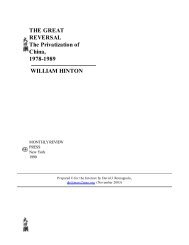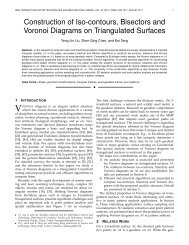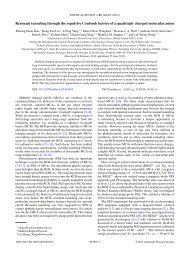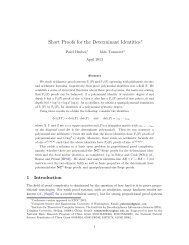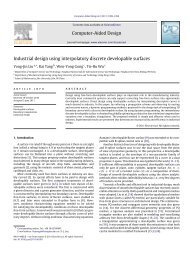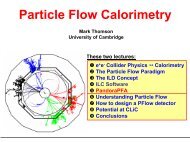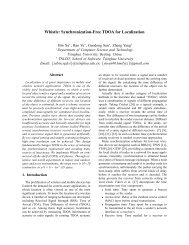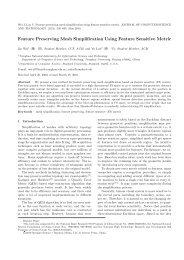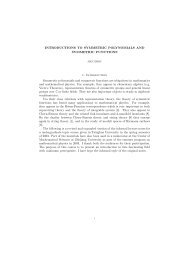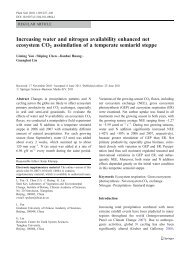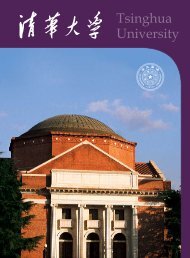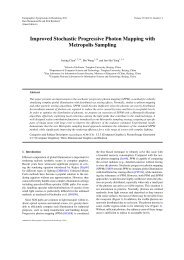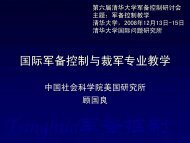Prosodic Boundary Prediction based on Maximum Entropy Model ...
Prosodic Boundary Prediction based on Maximum Entropy Model ...
Prosodic Boundary Prediction based on Maximum Entropy Model ...
You also want an ePaper? Increase the reach of your titles
YUMPU automatically turns print PDFs into web optimized ePapers that Google loves.
<str<strong>on</strong>g>Prosodic</str<strong>on</strong>g> <str<strong>on</strong>g>Boundary</str<strong>on</strong>g> <str<strong>on</strong>g>Predicti<strong>on</strong></str<strong>on</strong>g> <str<strong>on</strong>g>based</str<strong>on</strong>g> <strong>on</strong> <strong>Maximum</strong><br />
<strong>Entropy</strong> <strong>Model</strong> with Error-Driven Modificati<strong>on</strong> 1<br />
Xia<strong>on</strong>an Zhang, Jun Xu, Lianh<strong>on</strong>g Cai<br />
Key Laboratory of Pervasive Computing (Tsinghua University), Ministry of Educati<strong>on</strong>,<br />
Beijing 100084, P.R.China<br />
zxndelia724@gmail.com, xujun00@mails.tsinghua.edu.cn, clh-dcs@tsinghua.edu.cn<br />
Abstract. <str<strong>on</strong>g>Prosodic</str<strong>on</strong>g> boundary predicti<strong>on</strong> is the key to improving the<br />
intelligibility and naturalness of synthetic speech for a TTS system. This paper<br />
investigated the problem of automatic segmentati<strong>on</strong> of prosodic word and<br />
prosodic phrase, which are two fundamental layers in the hierarchical prosodic<br />
structure of Mandarin Chinese. <strong>Maximum</strong> <strong>Entropy</strong> (ME) <strong>Model</strong> was used at the<br />
fr<strong>on</strong>t end for both prosodic word and prosodic phrase predicti<strong>on</strong>, but with<br />
different feature selecti<strong>on</strong> schemes. A multi-pass predicti<strong>on</strong> approach was<br />
adopted. Besides, an error-driven rule-<str<strong>on</strong>g>based</str<strong>on</strong>g> modificati<strong>on</strong> module was<br />
introduced into the back end to amend the initial predicti<strong>on</strong>. Experiments<br />
showed that this combined approach outperformed many other methods like<br />
C4.5 and TBL.<br />
Keywords: <str<strong>on</strong>g>Prosodic</str<strong>on</strong>g> <str<strong>on</strong>g>Boundary</str<strong>on</strong>g> <str<strong>on</strong>g>Predicti<strong>on</strong></str<strong>on</strong>g>, <strong>Maximum</strong> <strong>Entropy</strong> <strong>Model</strong>, Error-<br />
Driven Rule-Based Modificati<strong>on</strong><br />
1 Introducti<strong>on</strong><br />
When people talk, they rarely speak out a whole sentence without a break. Instead, an<br />
utterance is divided into smaller units with perceivable boundaries between them.<br />
These ph<strong>on</strong>etic spurts or chunks of speech, which are comm<strong>on</strong>ly known as prosodic<br />
units, signal the internal structure of the message and serve important functi<strong>on</strong> in<br />
helping people to clearly express their ideas as well as their feelings.<br />
These units are different in their categories, levels, and boundary strength. Smaller<br />
and lower-level units are c<strong>on</strong>tained in larger and higher-level units to form a prosodic<br />
hierarchy. In Mandarin Chinese, this hierarchical structure is often simplified to 3<br />
layers [1] (from down to top): prosodic word, prosodic phrase and int<strong>on</strong>ati<strong>on</strong> phrase.<br />
In current TTS, input text is firstly processed by a Text Analysis <strong>Model</strong>, whose<br />
output is a string of syntactic words, each with a POS tagging. Then its prosodic<br />
structure is expected to be c<strong>on</strong>structed out of linguistic informati<strong>on</strong> to enhance the<br />
naturalness and understandability of the synthetic speech. However, as grammatical<br />
structure does not necessarily corresp<strong>on</strong>d to its prosodic counterpart, misjudgments<br />
1<br />
This work is supported by China Nati<strong>on</strong>al Natural Science Foundati<strong>on</strong>(60433030,<br />
60418012)
always occur in assigning the proper prosodic boundary, which has become the major<br />
impediment for TTS systems to achieve human-like performance.<br />
That’s why more and more attenti<strong>on</strong> has been paid to addressing the problem of<br />
automatic prosodic boundary predicti<strong>on</strong>. For Mandarin, as int<strong>on</strong>ati<strong>on</strong> phrases are<br />
usually distinguished by punctuati<strong>on</strong> marks, most efforts focus <strong>on</strong> locating prosodic<br />
word and prosodic phrase boundaries <str<strong>on</strong>g>based</str<strong>on</strong>g> <strong>on</strong> syntactic informati<strong>on</strong>.<br />
In the earlier time, rule-<str<strong>on</strong>g>based</str<strong>on</strong>g> methods were usually adopted. It mainly starts from<br />
Gee and Grosjean's work <strong>on</strong> performance structures [2], and has had various<br />
extensi<strong>on</strong>s over the years. For Chinese, similar investigati<strong>on</strong> has also been carried out<br />
into the formati<strong>on</strong> of prosodic c<strong>on</strong>stitutes, such as that reported by Jianfen Cao [1][3]<br />
and H<strong>on</strong>gjun Wang [4]. The central idea of all these work is to find some explicit<br />
rules that could recreate the prosodic structure of a sentence from syntax, by way of a<br />
large number of experiments and empirical observati<strong>on</strong>. This method is easily<br />
explicable and understandable, but also poses strict demand for the system developer<br />
to summarize these rules. Moreover, it is hard to update and improve, and the set of<br />
rules is usually c<strong>on</strong>strained to <strong>on</strong>e branch of language, which hinders its general<br />
applicati<strong>on</strong>.<br />
With the availability of increasing prosodically annotated corpora and the rapid<br />
development of statistical learning, stochastic-<str<strong>on</strong>g>based</str<strong>on</strong>g> approach has been more and<br />
more widely used in prosodic boundary predicti<strong>on</strong>. As in most cases, it is assumed<br />
that syntactic word is the smallest unit (i.e. leaf node) in a prosodic hierarchy tree, the<br />
task of building prosodic structure could be reduced to deciding the type for each<br />
syntactic word boundary, which is actually a classificati<strong>on</strong> problem. Thus many<br />
different statistical methods used for classificati<strong>on</strong> have been tried, such as<br />
Classificati<strong>on</strong> and Regressi<strong>on</strong> Tree (CART) used by Wang and Hirschberg [5], and<br />
Hidden Markov <strong>Model</strong> proposed by Paul and Alan [6]. Researchers in Chinese have<br />
also begun to adopt this approach during recent years. Besides those menti<strong>on</strong>ed<br />
above, Zhao has described methods for automatically predicting prosodic phrase by<br />
combining decisi<strong>on</strong> tree and TBL [7]. And in Li’s experiment, he attempted to predict<br />
prosody phrase break <str<strong>on</strong>g>based</str<strong>on</strong>g> <strong>on</strong> <strong>Maximum</strong> <strong>Entropy</strong> <strong>Model</strong> [8]. Generally, these<br />
methods relate each boundary site with some features (e.g. length and POS of<br />
adjacent words). By extracting and absorbing these features from a large collecti<strong>on</strong> of<br />
annotated sentences, a statistical model is trained and then applied to unlabeled texts.<br />
For each potential boundary site in the text, a probability is estimated for each<br />
possible outcome, and the <strong>on</strong>e with largest likelihood is determined as the correct<br />
type.<br />
In this paper, we proposed to predict the prosodic boundary using <strong>Maximum</strong><br />
<strong>Entropy</strong> <strong>Model</strong>, which nowadays has gained more and more popularity with NLP.<br />
Unlike previous efforts, we applied it to both prosodic word and prosodic phrase<br />
boundary labeling, and a multi-pass approach was employed for the latter task.<br />
Moreover, an error-driven rule-<str<strong>on</strong>g>based</str<strong>on</strong>g> modificati<strong>on</strong> module was added at the back end<br />
to improve the performance furthermore.<br />
The rest of this paper is organized as following. Secti<strong>on</strong> 2 first introduced the<br />
<strong>Maximum</strong> <strong>Entropy</strong> <strong>Model</strong> briefly. Then the feature selecti<strong>on</strong> method and the multipass<br />
procedure for prosodic boundary predicti<strong>on</strong> are presented. Secti<strong>on</strong> 3 described<br />
the back-end modificati<strong>on</strong> module. Experiments and results are given in Secti<strong>on</strong> 4.<br />
Secti<strong>on</strong> 5 gives c<strong>on</strong>clusi<strong>on</strong>s.
2 <str<strong>on</strong>g>Prosodic</str<strong>on</strong>g> Boudary <str<strong>on</strong>g>Predicti<strong>on</strong></str<strong>on</strong>g> <str<strong>on</strong>g>based</str<strong>on</strong>g> <strong>on</strong> <strong>Maximum</strong> <strong>Entropy</strong><br />
<strong>Model</strong><br />
In our experiment, a basic assumpti<strong>on</strong> is that a prosodic boundary <strong>on</strong>ly occurs at<br />
syntactic word boundaries. For Mandarin Chinese, it is reas<strong>on</strong>able as statistics show<br />
that <strong>on</strong>ly 6% of prosodic words are part of a l<strong>on</strong>g syntactic word, and all the rest agree<br />
with this assumpti<strong>on</strong>.<br />
Given a string of c<strong>on</strong>secutive syntactic words, for each boundary between two of<br />
them (say w i and w i+1 ), there are 3 types: LW (w i and w i+1 are within the same prosodic<br />
word), PW(within the same prosodic phase but different prosodic words) and<br />
PPh(within different prosodic phrases). Then our task comes down to deciding the<br />
right type for each syntactic word boundary, which could be accomplished with a<br />
<strong>Maximum</strong> <strong>Entropy</strong> <strong>Model</strong>.<br />
2.1 <strong>Maximum</strong> <strong>Entropy</strong> <strong>Model</strong>ing<br />
C<strong>on</strong>sider a random process that produces an output value y <str<strong>on</strong>g>based</str<strong>on</strong>g> <strong>on</strong> some c<strong>on</strong>textual<br />
informati<strong>on</strong> x, with x and y being a member of a finite set X and Y respectively. In our<br />
case, y is the type of a syntactic word boundary (i.e. LW, PW or PPh), and x could<br />
include any available informati<strong>on</strong> about that boundary.<br />
Our task is to c<strong>on</strong>struct a stochastic model that accurately represents the behavior<br />
of the random process. In other words, it should give a reliable estimati<strong>on</strong> of p(ylx),<br />
which denotes the c<strong>on</strong>diti<strong>on</strong>al probability that, given a c<strong>on</strong>text x, the process will<br />
output y.<br />
For this purpose, we observe the behavior of the random process for some time,<br />
collecting N samples (x 1 , y 1 ), (x 2 , y 2 ) . . . . . (x N , y N ). To express these facts, a feature<br />
functi<strong>on</strong> or feature for short is defined as:<br />
fi( x, y)<br />
= ⎧ ⎨<br />
⎩<br />
1<br />
0<br />
if y = y and x = x<br />
i i<br />
Otherwise<br />
The expected value of each feature f i with respect to the statistics of training<br />
samples could then be calculated as:<br />
p ( f i ) = ( , ) ( , )<br />
( x ∑ , y)<br />
p x y f i x y , .<br />
where p( x, y)<br />
is the empirical probability distributi<strong>on</strong> of the samples, defined by:<br />
1<br />
p( x, y) ≡ × number of times that ( x, y)<br />
occurs in the sample .<br />
N<br />
On the other hand, the expected value of f i with respect to the unknown model<br />
p(ylx) is:<br />
(1)<br />
(2)
p ( f ) = ∑ p( x) p( y<br />
i<br />
) ( )<br />
( )<br />
| x fi<br />
x , y , (3)<br />
x,<br />
y<br />
where p( x ) is the empirical distributi<strong>on</strong> of x in the training sample. We require the<br />
model to accord with the observed statistics by c<strong>on</strong>straining this value to be the same<br />
as the expected value of f in the training set. That is, for each f i<br />
p( f ) = p( f ) . (4)<br />
i i<br />
Requirement (4) is called a c<strong>on</strong>straint equati<strong>on</strong> or simply a c<strong>on</strong>straint.<br />
Combining (1), (3) and (4) we have:<br />
( ) ( ) ( )<br />
( ) ( )<br />
∑ | , , ,<br />
( , )<br />
p x p y x f i x y = ∑<br />
x y<br />
( x,<br />
y)<br />
p x y f i x y .<br />
Suppose we have n features, then all the probability distributi<strong>on</strong> that satisfy the<br />
c<strong>on</strong>straints exerted by these features c<strong>on</strong>stitute a set C:<br />
{ ( | ) | ( ) ( ) {1, 2,..., }<br />
C ≡ p y x p f<br />
i<br />
= p f<br />
i<br />
for i ∈ n .<br />
Am<strong>on</strong>g all the models p in C, the maximum entropy philosophy dictates that we<br />
select the <strong>on</strong>e with maximum c<strong>on</strong>diti<strong>on</strong>al entropy [9]<br />
( ) ( ) ( | ) log ( | )<br />
H p ≡ − ∑ p x p y x p y x ,<br />
x,<br />
y<br />
(5)<br />
(6)<br />
(7)<br />
and<br />
p* arg max H ( p)<br />
= . (8)<br />
p∈C<br />
It is a c<strong>on</strong>strained optimizati<strong>on</strong> problem to find p*. The target maximum entropy<br />
model has the following form[9]:<br />
1<br />
p * ( y | x) = exp( ∑ λi f<br />
i<br />
( x, y))<br />
.<br />
Z ( x)<br />
i<br />
λ<br />
where Z λ (x) is a normalizing c<strong>on</strong>stant and λ i is a Lagrange multiplier which is<br />
comm<strong>on</strong>ly computed from the training set using GIS algorithm. Detailed steps are<br />
omitted here.<br />
(9)<br />
2.2 Feature Selecti<strong>on</strong> Strategy<br />
The principle of <strong>Maximum</strong> <strong>Entropy</strong> <strong>Model</strong> is to agree with all that is known and<br />
assume nothing about what is unknown. Yet it poses another important questi<strong>on</strong>: how<br />
to find appropriate facts that are most relevant to the task in hand Put another way,
how to select a limited number of features that represents the ‘known’ fully and<br />
accurately<br />
In the first place, as prosodic phrase lies above prosodic word in the prosodic<br />
hierarchy, it should exhibit some ‘higher-level’ features than the latter. Taking this<br />
into account, we built two distinct models by incorporating into them different<br />
features for prosodic word and prosodic phrase predicti<strong>on</strong> respectively.<br />
Like Li [8], we used a semi-automatic approach for feature selecti<strong>on</strong>. First, feature<br />
‘templates’ are manually designed, which in effect defined the space of candidate<br />
features; then the most “useful” features are selected automatically using a simple<br />
count cut-off method with a threshold of 3.<br />
The feature ‘templates’ are so devised as to capture as much informati<strong>on</strong> about the<br />
random process as possible. For our specific applicati<strong>on</strong>, most comm<strong>on</strong>ly used<br />
features include POS (Part of Speech Tagging), WLen (length in syllables) and Word<br />
(the word itself) of the words surrounding the boundary, which have also proved to be<br />
the most important determinants of prosodic boundary types [10]. On account of this,<br />
we added them into too both templates, with a window length of 2 for POS, i.e. we<br />
c<strong>on</strong>sidered the POS of 2 words immediately before and after the boundary in<br />
questi<strong>on</strong>, and a window length of 1 for WLen and Word. A point to note, though, is<br />
that ‘word’ has different meaning under the two scenarios. For prosodic word, it<br />
indicates syntactic word and is readily available from the input text. For prosodic<br />
phrase, which is built up<strong>on</strong> prosodic words rather than syntactic words, the meaning<br />
accordingly changes to prosodic word. Here ‘POS’ property of a prosodic word is<br />
acquired by simply c<strong>on</strong>catenating POS’s of the syntactic words it c<strong>on</strong>tains (e.g. POS<br />
of ‘ 我 们 /rr 的 /ud’ is ‘rr ud’)<br />
Besides these widely used features, another category of features—‘dynamic<br />
feature’ were also introduced into the templates. The first is ‘lastType’, which denotes<br />
the last prosodic boundary type. The motive for adding this informati<strong>on</strong> came from<br />
the observati<strong>on</strong> that current boundary type is influenced by that of last <strong>on</strong>e, which<br />
applies to prosodic word as well as prosodic phrase boundary. For example, a<br />
‘lastType’ of PPh could well reduce the possibility that current boundary is still PPh.<br />
The sec<strong>on</strong>d was specially proposed for prosodic phrase segmentati<strong>on</strong>. We noted<br />
that, to a large extent, inserti<strong>on</strong> of prosodic phrase boundaries in natural spoken<br />
language is to balance the length of the c<strong>on</strong>stituents in the output. Hence it is not<br />
surprising that most PPh breaks occur in the middle part of a l<strong>on</strong>g sentence, and a<br />
prosodic phrase is usually 5~7 syllables l<strong>on</strong>g, but rarely shorter than 3 or l<strong>on</strong>ger than<br />
9 syllables. For this reas<strong>on</strong>, we took into c<strong>on</strong>siderati<strong>on</strong> length measures by including<br />
‘dBack’ and ‘dFr<strong>on</strong>t’ in our templates for prosodic phrase predicti<strong>on</strong>, which means<br />
the distance (in syllables) from current boundary to the last and next nearest PPh<br />
locati<strong>on</strong>.<br />
This category of features is by definiti<strong>on</strong> ‘dynamic’ in that they rely <strong>on</strong> the result of<br />
previous predicti<strong>on</strong>, and remains unknown until judgment <strong>on</strong> preceding boundaries<br />
has been made. By c<strong>on</strong>trast, the usual ‘static’ features are fixed and known all the way<br />
<strong>on</strong>ce the input is given.<br />
The feature templates c<strong>on</strong>tained both atomic and composed <strong>on</strong>es. Atomic templates<br />
c<strong>on</strong>sidered <strong>on</strong>ly <strong>on</strong>e element menti<strong>on</strong>ed above, while composed templates are<br />
combinati<strong>on</strong> of atomic <strong>on</strong>es. Table 1 lists all the atomic templates.
Table 1. Atomic Templates Used in Two <strong>Maximum</strong> <strong>Entropy</strong> <strong>Model</strong><br />
Atomic<br />
Templates<br />
PW&PPh <str<strong>on</strong>g>Predicti<strong>on</strong></str<strong>on</strong>g> 1 st Pass<br />
(<strong>Model</strong> 1)<br />
PPh <str<strong>on</strong>g>Predicti<strong>on</strong></str<strong>on</strong>g> 2 nd &3 rd Pass(<strong>Model</strong> 2)<br />
Symbol Meaning Symbol Meaning<br />
POS-2<br />
POS-1<br />
POS+1<br />
POS+2<br />
POS of the 1 st /2 nd<br />
syntactic word<br />
before/after the<br />
boundary<br />
POS-2<br />
POS-1<br />
POS+1<br />
POS+2<br />
POS of the 1 st /2 nd prosodic word<br />
before/after the boundary<br />
Word-1<br />
Word+1<br />
WLen-1<br />
WLen+1<br />
lastType<br />
1 st syntactic word<br />
itself before/after the<br />
boundary<br />
length of 1 st<br />
syntactic word<br />
before/after the<br />
boundary<br />
boundary type after<br />
last syntactic word<br />
(LW/PW/PPh)<br />
Word-1<br />
Word+1<br />
WLen-1<br />
WLen+1<br />
lastType<br />
dFr<strong>on</strong>t/<br />
dBack<br />
1 st prosodic word itself<br />
before/after the boundary<br />
length of 1 st prosodic word<br />
before/after the boundary<br />
boundary type after last prosodic<br />
word (PW/PPh)<br />
distance from current positi<strong>on</strong> to<br />
last/next PPh boundary<br />
2.3 Multi-Pass <str<strong>on</strong>g>Predicti<strong>on</strong></str<strong>on</strong>g><br />
In both our experience and experiments, we found that it’s much easier to locate<br />
prosodic word boundaries accurately. It could be explained by the observati<strong>on</strong> that<br />
distributi<strong>on</strong> of this kind of boundaries largely depends <strong>on</strong> local syntactic c<strong>on</strong>straints<br />
and exhibits more regular patterns that could be derived from low-level syntax<br />
analysis. On the other hand, prosodic phrasing is a compromise between the need to<br />
respect the syntax structure of the sentence and the prosodic c<strong>on</strong>straints, which could<br />
hardly be decided in the normal <strong>on</strong>e-pass classificati<strong>on</strong> soluti<strong>on</strong>.<br />
That’s why we came up with the idea of multi-pass predicti<strong>on</strong> to determine<br />
prosodic phrase boundaries. The whole process is described in Figure 1. As<br />
menti<strong>on</strong>ed earlier, 2 separate models were trained with different feature sets during<br />
the training stage. In testing, the 1 st -pass predicti<strong>on</strong> used <strong>Model</strong> 1 at every syntactic<br />
word boundary to decide its type: LW, PW, or PPh. At this time, our major c<strong>on</strong>cern<br />
was to differentiate between PW and LW boundaries, and merely those most<br />
‘credible’ PPh’s were labeled as PPh’s. That is, <strong>on</strong>ly when <strong>Model</strong> 1 decided that the<br />
probability of a boundary to be PPh is higher than a certain threshold (say threshold1),<br />
were we assured that it actually was PPh. Otherwise we still classified it as PW and<br />
left it to the next pass. It is worth to menti<strong>on</strong> that though <strong>Model</strong> 1 was mainly targeted<br />
at PW predicti<strong>on</strong>, it’s sensible and necessary to label out some PPh’s at the same time.<br />
For <strong>on</strong>e thing, those PPh’s with a high degree of c<strong>on</strong>fidence are mostly where we<br />
‘have to break’ governed by syntax or grammatical c<strong>on</strong>straints. For another,<br />
identifying these PPh positi<strong>on</strong>s also enabled us to acquire the ‘dBack’ feature in<br />
following predicti<strong>on</strong>s.
T r a i n i ng S ta g e<br />
T e s t in g St a g e<br />
Ex t r a c t F e a t u r e s<br />
: s y n t a c t i c w o r d<br />
P O S , W L e n ,<br />
W o r d , l a s t T y p e<br />
Tr ai n<br />
M o d e l 1<br />
1 st P a s s<br />
U n a n n o t a t e d Te x t<br />
A n n o t a t e d<br />
C o r p u s<br />
E x t r a c t F e a t u r e s :<br />
p r o s o d i c w o r d<br />
P O S , W L e n ,<br />
W o r d , ,<br />
la s t Ty p e ,<br />
d F r o n t , d B a c k<br />
Tr ai n<br />
M o d e l 2<br />
L W<br />
L a b e l L W<br />
2 n d P a s s<br />
P r e d i c t i o n =<br />
N<br />
P W<br />
L a b el P W<br />
R e s u l t o f 1 st P a s s<br />
P r e di c ti o n= <br />
P P h<br />
p > t h res h o l d1<br />
Y<br />
L a b e l P P h<br />
P P h<br />
N o n - P P h<br />
N<br />
L a b e l P W<br />
p > t h r e s h o l d 2<br />
Y<br />
L ab e l P P h<br />
3 r d Pa s s<br />
R esu lt o f 2 n d P a s s<br />
N o n - P P h<br />
P re d ic t io n = <br />
L ab e l P W<br />
P Ph<br />
L a b e l P P h<br />
F i n a l A n n o t a t i o n<br />
Fig. 1. Procedure of Multi-Pass <str<strong>on</strong>g>Predicti<strong>on</strong></str<strong>on</strong>g><br />
The 2 nd and 3 rd pass <strong>on</strong>ly worked <strong>on</strong> PW boundaries labeled in the 1 st pass. They<br />
both used <strong>Model</strong> 2 to decide whether a PW indeed was PW, or should be classified as<br />
PPh. The <strong>on</strong>ly difference with these two pass is that during the 2 nd pass, we still didn’t<br />
take the result literally: <strong>on</strong>ly when the estimated probability of a boundary to be PPh<br />
was higher than threshold2, did we trust it to be an ‘authentic’ PPh. However, in the<br />
last pass, we accepted the model’s judgment unc<strong>on</strong>diti<strong>on</strong>ally.<br />
We did this mainly because those PPh’s decided in the latter stage of our predicti<strong>on</strong><br />
chiefly corresp<strong>on</strong>d to those breaks that we ‘d<strong>on</strong>’t have to make but could make’ out of
prosodic c<strong>on</strong>straints, and thus had better to be refined step by step to achieve the best<br />
balance in length.<br />
Another questi<strong>on</strong> unaddressed is the set of threshold1 and threshold2, which turned<br />
out to have a c<strong>on</strong>siderable influence <strong>on</strong> the final outcome. After repeated experiments,<br />
it was found that a value of 0.65 and 0.7 for threshold1 and threshold2 respectively<br />
achieved the best performance.<br />
3 Error-Driven Rule-Based Modificati<strong>on</strong><br />
In our preliminary experiment using <strong>on</strong>ly <strong>Maximum</strong> <strong>Model</strong> for predicti<strong>on</strong>, we found<br />
that there were always some obvious mistakes that humans would never commit as<br />
they obviously c<strong>on</strong>tradicted to some ‘fixed patterns’ we were accustomed to. It then<br />
occurred to us that these mistakes might be corrected with manually-made rules.<br />
3.1 Rules<br />
Every rule is a pair with the form of ‘predicate => acti<strong>on</strong>’. When and <strong>on</strong>ly when the<br />
pre-c<strong>on</strong>diti<strong>on</strong> described by ‘predicate’ is satisfied, will a rule be activated, and then<br />
corresp<strong>on</strong>ding ‘acti<strong>on</strong>’ will be taken.<br />
For example, the fact that ‘A boundary succeeded by syntactic word “ 的 ”or<br />
“ 得 ”must be a LW boundary’ could be written as the following rule:<br />
WORD -1 = 的 or WORD -1 = 得 ⇒ Boudary ← LW<br />
3.2 Basic Process<br />
The rule-<str<strong>on</strong>g>based</str<strong>on</strong>g> modificati<strong>on</strong> module was added at the back-end of the system to<br />
amend the predicti<strong>on</strong> from <strong>Maximum</strong> <strong>Entropy</strong> <strong>Model</strong>. To evaluate whether adding a<br />
rule does improve the performance, the metric ‘F-Score’ (detailed later in 4.1) was<br />
used. A brief working process is shown in Figure 2.<br />
We compared the result of automatic annotati<strong>on</strong> with manual annotati<strong>on</strong> to detect<br />
errors made by the machine. By observing the statistics, a rule was derived to correct<br />
them. In most cases, errors first got rectified were those most amendable <strong>on</strong>es, i.e.,<br />
errors which exhibited some evident patterns. Every time a rule was worked out, it<br />
was tried out <strong>on</strong> the whole testing corpus to see whether the resulting new F-Score<br />
was notably higher than that of last time. If it didn’t, the rule was just ignored;<br />
otherwise it was adopted and applied. New errors might occur and this process<br />
repeated, until no rules could be manually found.<br />
The underlying idea of this module is a bit like that of TBL (Transformati<strong>on</strong>-Based<br />
Error-Driven Learning) [11]: It starts from an initial state, and by use of a series of<br />
transformati<strong>on</strong> rules, it modifies the result bit by bit to achieve the best score<br />
according to the objective functi<strong>on</strong> used. It’s <strong>on</strong>ly that in TBL, the transformati<strong>on</strong>s are
learnt automatically (typically by greedy search algorithms); but in our soluti<strong>on</strong>, these<br />
rules are manually formulated to avoid the heavy computati<strong>on</strong>al cost.<br />
For now a total of 15 rules were added.<br />
<strong>Maximum</strong> <strong>Entropy</strong> <strong>Model</strong><br />
Initial State<br />
Annotated Text<br />
Compare&<br />
Summarize<br />
Rule<br />
Test<br />
F-Score Higher<br />
Standard Text<br />
No<br />
Yes<br />
Add the Rule & Update<br />
Annotated Text<br />
Fig. 2. Basic Process of Post-modificati<strong>on</strong><br />
4 Experiment and Result<br />
4.1 Preparati<strong>on</strong><br />
Our raw corpus comprises 10000 sentences randomly selected from People’s Daily<br />
2000. Each sentence had been segmented into a sequence of syntactic words with<br />
POS tags according to “Specificati<strong>on</strong> for Corpus Processing at Peking University:<br />
Word Segmentati<strong>on</strong>, POS Tagging and Ph<strong>on</strong>etic Notati<strong>on</strong>” (shortened as<br />
“Specificati<strong>on</strong> 2003”). On average, <strong>on</strong>e sentence c<strong>on</strong>tains 45.24 syllables and 25.15<br />
syntactic words.<br />
Then this corpus was prosodically annotated by two trained people, who were<br />
c<strong>on</strong>sistent <strong>on</strong> more than 90% of their annotati<strong>on</strong>. Both prosodic words and prosodic<br />
phrase boundaries were marked out. The whole process was guided and supervised by<br />
an expert (Jianfen Cao of Chinese Academy of Social Sciences).<br />
Am<strong>on</strong>g the 10000 sentences, 4500 were used for training and 2000 were used for<br />
testing in all of the following experiments. The two sets did not overlap each other.
4.2 Evaluati<strong>on</strong> Criteria<br />
Since subjective tests are time-c<strong>on</strong>suming and costly to perform, we adopted an<br />
objective point of reference.<br />
As menti<strong>on</strong>ed earlier, there are altogether 3 prosodic boundary types between two<br />
syntactic words w i and w i+1 : LW, PW and PPh. For simplicity in notati<strong>on</strong>, we here<br />
refer to them as B 0 , B 1 and B 2 respectively. To evaluate the performance of our<br />
system, the prosodic boundaries automatically assigned to the testing set were<br />
compared to human-annotati<strong>on</strong>. In this way a c<strong>on</strong>fusi<strong>on</strong> matrix was acquired, as<br />
shown in Table 2. In the table, C ij denotes the number of boundaries manually labeled<br />
as B i and predicted to be B j .<br />
Table 2. C<strong>on</strong>fusti<strong>on</strong> Maxtrix<br />
Manually<br />
Predicted Type<br />
Labeled Type B 0 B 1 B 2<br />
B 0 C 00 C 01 C 02<br />
B 1 C 10 C 11 C 12<br />
B 2 C 20 C 21 C 22<br />
Our evaluati<strong>on</strong> metric Precisi<strong>on</strong> and Recall were computed as:<br />
For prosodic word boundary predicti<strong>on</strong>:<br />
2 2 2 2<br />
∑ ∑ C<br />
Precisi<strong>on</strong> = , Recall =<br />
∑ ∑ C<br />
∑ ∑ C<br />
ij<br />
j=1 i=1 j=1 i=1<br />
1 2 2 1 2 2<br />
ij<br />
j=0 i=1 i=0 j=1<br />
ij<br />
∑ ∑ C<br />
ij<br />
.<br />
(10)<br />
For prosodic phrase boudnary predicti<strong>on</strong>:<br />
Precisi<strong>on</strong> =<br />
C<br />
, Recall =<br />
∑ C<br />
22 22<br />
2 2 2 2<br />
C<br />
∑ C<br />
2 j i2<br />
j=0 i=0<br />
.<br />
(11)<br />
Another measurement F-Score takes both into c<strong>on</strong>siderati<strong>on</strong>:<br />
2 × Precisi<strong>on</strong> × Recall<br />
F - Score =<br />
i i<br />
( i = 1, 2) .<br />
i Precisi<strong>on</strong><br />
i + Recall<br />
i<br />
(12)<br />
4.3 Effect of Adding Rules<br />
Figure 3 shows the test results for prosodic words segmentati<strong>on</strong> when the number of<br />
rules gradually increased from 0 to 15. Since <strong>Maximum</strong> <strong>Entropy</strong> <strong>Model</strong> al<strong>on</strong>e was<br />
able to achieve a relatively high accuracy with a large training corpus (4500 sentences<br />
in our case), the post-processing module doesn’t seem to be playing a significant part.
Yet there is still notable rise in all three measures. When training material is of a<br />
small size and linguistic feature values are sparse, more remarkable improvement<br />
could be expected.<br />
0.97<br />
0.96<br />
0.95<br />
0.94<br />
0.93<br />
0.92<br />
0.91<br />
0 2 7 15<br />
Precisi<strong>on</strong><br />
Recall<br />
F-Score<br />
Fig. 3. <str<strong>on</strong>g>Prosodic</str<strong>on</strong>g> Word <str<strong>on</strong>g>Boundary</str<strong>on</strong>g> <str<strong>on</strong>g>Predicti<strong>on</strong></str<strong>on</strong>g> Result When Adding Rules<br />
4.4 General Performance<br />
Table 4 gives the testing result of our system, with threshold1=0.65 and threshold2=<br />
0.7 for multi-pass predicti<strong>on</strong>. Best results of some other approaches adopted in<br />
previous experiments are also listed for comparis<strong>on</strong>.<br />
Table 4. Best Test Result in Comparis<strong>on</strong> with Other Methods<br />
<str<strong>on</strong>g>Prosodic</str<strong>on</strong>g> Word<br />
<str<strong>on</strong>g>Prosodic</str<strong>on</strong>g> Phrase<br />
Precisi<strong>on</strong> Recall F-Score Precisi<strong>on</strong> Recall F-Score<br />
C4.5 [7] 0.814 0.822 0.818 0.712 0.829 0.766<br />
TBL [7] 0.782 0.848 0.814 0.853 0.613 0.713<br />
ME <strong>Model</strong>[8] N/A N/A N/A N/A N/A 0.652<br />
Our Approach 0.936 0.963 0.949 0.798 0.784 0.791<br />
Due to difference in the corpora and evaluati<strong>on</strong> metric, these results may not be<br />
comparable in all respects. Yet from the statistics above, we could safely say that our<br />
approach is a successful attempt towards prosodic boudary predicti<strong>on</strong>. .<br />
5 C<strong>on</strong>clusi<strong>on</strong>s<br />
In this paper, we addressed the problem of prosodic boudary predicti<strong>on</strong> <str<strong>on</strong>g>based</str<strong>on</strong>g> <strong>on</strong><br />
syntactic informati<strong>on</strong>. The <strong>Maximum</strong> <strong>Entropy</strong> <strong>Model</strong> was utilized with two separate<br />
instantiati<strong>on</strong> for prosodic word and prosodic phrase segmentati<strong>on</strong>. Our feature<br />
selecti<strong>on</strong> strategy was distinctive in that it not <strong>on</strong>ly drew <strong>on</strong> generally 'static' syntactic<br />
c<strong>on</strong>text, but also c<strong>on</strong>sidered the interplay am<strong>on</strong>g successive boundary positi<strong>on</strong>s by<br />
incorporating 'dynamic' features into the model. It gave a satisfying performance<br />
especially for prosodic word predicti<strong>on</strong>. For prosodic phrase predicti<strong>on</strong>, even though
lack of high-level syntactic and semantic informati<strong>on</strong> impeded its accurate predicti<strong>on</strong>,<br />
a multi-pass procedure served to strike a better prosodic balance. Besides, the<br />
combinati<strong>on</strong> of machine learning power and human wisdom through error-driven<br />
ruled-<str<strong>on</strong>g>based</str<strong>on</strong>g> modificati<strong>on</strong> further enhanced its performance.<br />
Future work should focus <strong>on</strong> extracti<strong>on</strong> of ‘deeper’ c<strong>on</strong>textual informati<strong>on</strong> such as<br />
sense group and semantic chunk to aid the percepti<strong>on</strong> of prosodic phrase boundaries.<br />
Moreover, the inherent uncertainty in prosody structure in natural language may<br />
require a more flexible approach to its predicti<strong>on</strong>, possibly by using a minimum errorrate<br />
criteri<strong>on</strong> (MERC) [12] in place of the traditi<strong>on</strong>al maximum correct-rate criteri<strong>on</strong><br />
currently adopted by us.<br />
References<br />
[1] Jianfen Cao: <str<strong>on</strong>g>Predicti<strong>on</strong></str<strong>on</strong>g> of <str<strong>on</strong>g>Prosodic</str<strong>on</strong>g> Organizati<strong>on</strong> Based <strong>on</strong> Grammatical Informati<strong>on</strong>.<br />
Journal of Chinese Informati<strong>on</strong> Processing, Vol. 17. (2003) 41–46<br />
[2] Gee J.P., Grosjean F: Performance structures: A psycholinguistic and Linguistic Appraisal.<br />
Cognitive Psychology, Vol. 15. (1983) 411–458<br />
[3] Jianfen Cao, Weibin Zhu: Syntactic and Lexical C<strong>on</strong>straint in <str<strong>on</strong>g>Prosodic</str<strong>on</strong>g> Segmentati<strong>on</strong> and<br />
Grouping. In: Proceedings of Speech Prosody 2002. Aix-en-Provence, France (2002)<br />
[4] H<strong>on</strong>gjun Wang: <str<strong>on</strong>g>Prosodic</str<strong>on</strong>g> words and prosodic phrases in Chinese. Chinese Language,Vol. 6.<br />
(2000) 525–536<br />
[5] Wang M., Hirschberg J.: Predicting Int<strong>on</strong>ati<strong>on</strong>al Boundaries Automatically from Text, In:<br />
the ATIS Domain Proceedings of the DARPA Speech and Natural Language Workshop,<br />
(199l) 378–383<br />
[6] Paul Taylor, Alan. W. Black: Assigning phrase breaks from part-of speech sequences,<br />
Computer Speech and Language, Vol. 12(4). (1998) 99–117<br />
[7] Z Sheng, T Jianhua, C Lianh<strong>on</strong>g: Learning rules for Chinese prosodic phrase predicti<strong>on</strong>.<br />
Internati<strong>on</strong>al C<strong>on</strong>ference <strong>on</strong> Computati<strong>on</strong>al Linguistics, Proceeding of the first SIGHAN<br />
workshop <strong>on</strong> Chinese language processing, Vol. 18. (2002)<br />
[8] Jian-Feng Li, Guo-Ping Hu, Renhua Wang: Chinese prosody phrase break predicti<strong>on</strong> <str<strong>on</strong>g>based</str<strong>on</strong>g><br />
<strong>on</strong> maximum entropy model, In: Interspeech 2004, Jeju Island, Korea. (2004) 729–732<br />
[9] BERGER AL, STEPHEN A, DELLA PIETRA SA, et al: A maximum entropy approach to<br />
natural language processing [J]. Computati<strong>on</strong>al Linguistics, Vol. 22(1). (1996) 39–71<br />
[10] Min Zheng, Lianh<strong>on</strong>g Cai: <str<strong>on</strong>g>Prosodic</str<strong>on</strong>g> C<strong>on</strong>stituents Segmentati<strong>on</strong> and Syntax of Chinese: In:<br />
Proceeding of 5th Chinese Lexical Semantics Workshop, Singapore (2004)<br />
[11] Brill, Eric: Transformati<strong>on</strong>-Based Error-Driven Learning and Natural Language<br />
Processing: A Case Study in Part-of-Speech Tagging. Computati<strong>on</strong>al Linguistics. Vol. 21(4).<br />
543–565<br />
[12] Min Chu: The Uncertainty in Prosody of Natural Speech and Its Applicati<strong>on</strong> in Speech<br />
Synthesis, Journal of Chinese Informati<strong>on</strong> Processing, Vol. 18(4). (2004) 66–71



